Notes About Networks
This is one of 50 posts about cyborgs, a project to commemorate the 50th anniversary of the coining of the term.
Where Do Cyborgs Come From?
The term cyborg is as evocative and cuts as elusive a figure now as at the time of its minting half a century ago. Its fusion of what appear to be vastly different ontological orders—the machinic and the organic—augurs the advent of entities monstrous and beautiful and who possess unfathomable power. The cyborg, for all its reality in our present era, is a creature of fantasy, desire, hope, and horror and how we come to understand cyborg ontology ramifies through every conceivable form of being we (can) know.
The machinic component of the term “cyborg,” Molly Wright Steenson reminds us, derives from the term “cybernetic,” which characterizes systems according to the way in which information is used to modify the operation of those systems. Norbert Wiener isolates the generation and transmission of (this) information in cybernetic systems and names it “feedback.” By modeling and responding to external conditions, cybernetic systems take what is outside into their insides. It’s a question of containership.
Containership (a subset of the more comprehensive subject of topology) is useful to understanding some of the singular features of cybernetic systems. For example, elsewhere I have argued that recursive architectures “multiply small inputs” and so represent “an engineering strategy fundamental to modern computing and cybernetics”. Recursive architectures multiply small effects, similar to the» butterfly effect that characterizes metereological (non-linear dynamic) systems in chaos theory. Kevin Kelly captures one of the most important aspects of informatic feedback and recursion when he discusses their effects on our shared evolution. Kelly writes
We are different physical beings from our ancestors. We think differently. Our educated and literate brains work differently. We know that literacy changes how our brains work. More than our hunter-gatherer ancestors, we are shaped by the accumulating wisdom, practices, traditions, and culture of all those who’ve lived before us and live with us. We are cramming our lives with ubiquitous messages, science, pervasive entertainment, travel, surplus food, abundant nutrition, and new possibilities every day. At the same time, our genes are racing to keep up with culture. And we are speeding the acceleration of those genes by several means, including medical interventions such as gene therapy. In fact, every trend of the technium – especially its increasing evolvability – points to a much more rapid change of human nature in the future.
Kevin Kelly
Kelly makes the important point that as part of a larger cyborg system that has the ability to alter the reproduction of one of its components at the biogenetic level, the human species affects its evolution by changing the way in which humans make sense of the world.
We Have Never Been Cyborgs
We don’t yet know the final outcome of the emergence of cyborgs, whether humans will become robotlike clones with downloadable brains or will multi-cellular organisms all but disappear and Earth’s atmosphere choke with soot and insectoid flying machines or will things continue pretty much as they always have except more normal.
We also don’t know the extent of cyborg nature. The figure of the cyborg calls into question the categories of inanimateness, vitality, and sentience. From the representation of technē as a revealing in Heidegger to the discussion of cybernetic systems by McLuhan to the ethnographies of people with virtually mediated selves by Turkle to the popular representations of the cyborg as a faceless collective/malicious agent/hapless benefactor—between all these the one thing of which we can be sure is that cyborgs do not have a singular morphology or behavior. I’d like to make one (not so) radical proposal.
We don’t know what a cyborg is because there is no such thing as a cyborg. But wait, you say. Of course there are cyborgs. Look at this cyborg, you say. Just look at it.

Cyberdyne Systems Model 101, Rotting
Unquestionably, I would respond, that appears to be a cyborg. Measuring from that image, one could presume cyborgs to exist. But I want to consider more closely Tim Maly’s answer to the question of What’s a Cyborg? where he challenges popular cinematic representations of cyborgs as entities whose organism is obscured/overtaken by mechanism. Maly notes that prosthetically-enhanced humans (e.g. paralympic athletes and amputees) are strictly temporarily enhanced with optional and interchangeable equipment and makes a case that our truest vision of a cyborg is a bestacled lip-pierced woman who may have a chemically-enhanced nervous system.
Maly’s representational hat tip to Donna Haraway’s A Cyborg Manifesto not only presents us with a female counter to stereotypically masculinzed representations of cyborgs. It also reminds us a cyborg’s extent need not be limited the dermal boundaries of an organism. Haraway writes
Why should bodies end at skin? From the seventeenth century till now, machines could be animated—given ghostly souls to make them speak or move or to account for their orderly development and mental capacities. Or organisms could be mechanized—reduced to body understood as a resource of mind. These machine/organism relationships are obsolete, unnecessary. For us, in imagination and in other practice, machines can be prosthetic devices, intimate components, friendly selves.
Donna Haraway
A cyborg might be a discrete humanoid or it might be materialized as a system» of interlinked entites such as a human and an on-board computer or it might be a widely distributed system (e.g. a microprocessor fabrication plant») whose constituent parts include humans, non-human animals, machines, and artificial intelligences. In other words, a cyborg might be comprised of any number constitutent parts and have any size or shape that can (and can’t) be imagined as long as some of those parts are machinic and others organic: a definition whose inclusiveness renders it nearly useless.
Cyborgs have no definite form because they comprise a hybrid category which designates systems whose constituent parts come from disparate ontological orders.
In We Have Never Been Modern, Bruno Latour asserts that the foundational principle of the Modern Constitution—the separation of nature from culture—never happened, that what scientists regarded» as laws of nature were, in fact, observations of the interaction between humans, machines, and non-humans. For Latour, there is no pure space of nature or culture, only nature-culture hybrids. I would like to make a similar proposal with regard to cyborgs which is that cyborgs never came into being because systems that integrate organisms and machines have always existed.
The Cyborg’s Stroll
In their challenge to the» psychoanalytic estblishment whose model of psyche componetizes the mind and whose model for social connection isolates individuals from each other, Gilles Deleuze and Félix Guattari articulate a vision of the world wherein everything is interconnected. They take as a model» Jakob Michael Reinhold Lenz’s sense that it must be a feeling of endless bliss to be in contact with the profound life of every form, to have a soul for rocks, metals, water, and plants, to take into himself, as in a dream, every element of nature, like flowers that breathe with the waxing and waning of the moon (qtd. in Deleuze). Leaving aside for now the problems that arise when articulating a worldview that partially originates from a fictional account of schizophrenia, itself largely understood as a failure to apprehend the real world in which we live, I want to look at the words which precede Deleuze and Guattari’s excerpt. There, Büchner writes
[Lenz told Oberlin] that once in the mountains he had been thrown into a sort of trance as a result of looking into a deep, empty mountain pool. Lenz said that the spirit of the waters had come over him, too, and that it was then that he had discovered things about his own being. He continued. He said that the simplest, purest people were those who were near the elemental; that the more refined a man’s feelings and life, the more blunted this elemental sense becomes. He did not consider this a very high form of being, it wasn’t self-sufficient enough; but he thought that it must be a feeling of endless bliss[ . . . .]
Büchner, Georg
The harmonious perception of all that exists and its interconnectedness (elemental sense) is here expressed as something distinct from refined [. . .] feelings and life, distinct that is from culture. To move from culture to a sense of the elemental is, in this view, to gain blissful understanding of the profound life of every form including rocks, metals, water, and plants. To move into the elemental is to internalize (to take into himself) every element of Nature.
This view connects everything existent (plants, animals, metals, molecules, rocks, etc.) with no distinction between the vital and the inert, the quick and the inanimate, the living and the non-living and, in the ontological order of the cyborg, the organic and the machinic.
Love in the Uncanny Valley
In the very place Lenz reaches a kind of spiritual epiphany wherein he recognizes a fundmental sameness and interconnection between living and non-living things, others encounter the Uncanny. The origins of the uncanny trace back to Freud’s interpretation of the loss of eyes in E. T. A. Hoffmann’s The Sandman.
In Hoffmann’s story, Nathaniel unwittingly falls in love with an automaton named Olympia and loses his mind when he discovers she is a machine. Nathaniel does not gain a euphoric understanding of the interconnection between machine and organism, and his horrified reaction and descent into insanity became staples of gothic fiction long ago. Besides having been published in 1817, Hoffmann’s The Sandman shares another element with Mary Shelley’s Frankenstein: Or, the Modern Prometheus, arguably the earliest and most renown work of horror and science fiction.
That shared element is reproduction anxiety. Nathaniel perceives his beloved Clara as an automaton and Olympia as vitally responsive, perceptions which suggest Nathaniel has little choice regarding even whom he loves. He is overcome by Olympia’s beauty, a beauty apparent to all», and he perceives her mechanical exhalations ("Ah - ah!") as genuine hieroglyphics of [an] inner world, full of love and deep knowledge of the spiritual life, and contemplation of the eternal beyond. Nathaniel’s vanity and self-absorption enable him to sit for hours every day, uttering strange fantastical stuff about his love, about the sympathy that glowed to life, about the affinity of souls, all while provoking no more reaction than a sigh or two. For Nathaniel, Olympia’s motionless attention is a feature not a bug.
Nathaniel is on one level right regarding the “affinity of souls” between him and Olympia becuase, for all his organicity, he behaves as mechanically as she. Spun another way, Nathaniel’s self-absorbed behavior with Olympia is characteristic of a young man’s love for a beautiful but somewhat lifeless young woman.» However one chooses to read Nathaniel’s falling in love with a machine, a much wider horror spreads from the story’s center which is that love explained in terms of empathy, attention, and the “affinity of souls” may have for constituents people who behave as machines. Love produces machines made of people and these machine-people express their feelings (of love) in terms of compatibility and the affinity of souls, etc. See the problem?
Reproduction anxiety takes different form in Shelley’s Frankenstein, most notably in that the agonist’s fear of being overrun by a race of monsters is shared by the reader».
Reproduction Anxiety
Frankenstein destroys the companion his creature bade him create because he fears what should become of humans if this unprecedented being gained the power to propagate as a species. Frankenstein recounts
Even if they were to leave Europe, and inhabit the deserts of the new world, yet one of the first results of those sympathies for which the daemon thirsted would be children, and a race of devils would be propagated upon the earth who might make the very existence of the species of man a condition precarious and full of terror. Had I right, for my own benefit, to inflict this curse upon everlasting generations? I had before been moved by the sophisms of the being I had created; I had been struck senseless by his fiendish threats: but now, for the first time, the wickedness of my promise burst upon me; I shuddered to think that future ages might curse me as their pest, whose selfishness had not hesitated to buy its own peace at the price, perhaps, of the existence of the whole human race.
Mary Shelley
Victor Frankenstein, maniacal inventor and secular blasphemer, believes that to give vitality to an autopoietic non-human species» is to risk the extinction of humans. Frankenstein’s terror of creation, procreation, and reproduction moves him to destroy an artificial intelligence, a cyborg comprised of sutures, organs, and electricity.
But the extent of the monster’s body includes also: Frankenstein’s skill and education; the books from which he learned language; the “beloved cottagers” from whom the monster learns of family life; the victuals which sustain him and which he cultivates; the sun and wind and rain that provide energy within the milieu in which the monster is located; and so on. It would be one thing to say the monster is a cyborg and it would be the same thing to say he is also a network of heterogeneous elements located in disparate ontological orders.
Shelley is among our earliest human forbears with something to say about the boundary between organism and machine and, through her novel’s eponymous agon, she warns of a coming war between humans and cyborgs.
Popular Culture and the Cyborg Condition
Popular culture is replete with warnings of the dangers posed by cyborg systems and many of the most renowned examples dramatize the crisis that ensues once non-organic life achieves autopoiesis. One non-random example is Ridely Scott’s 1979 Alien.
The crew of the Nostromo’s encounter with a hostile extraterrestrial is not only about a parasitic life form whose body parts resemble machinery. It is also about the relationship between organic intelligence and artificial intelligence, a gothic parable about the intrication of humans, animals, and machines.
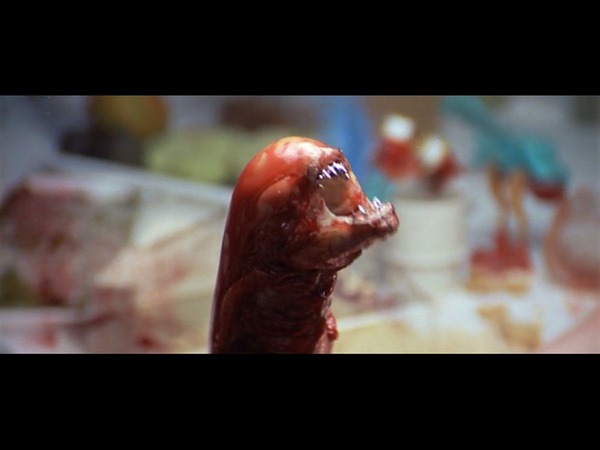
Larva
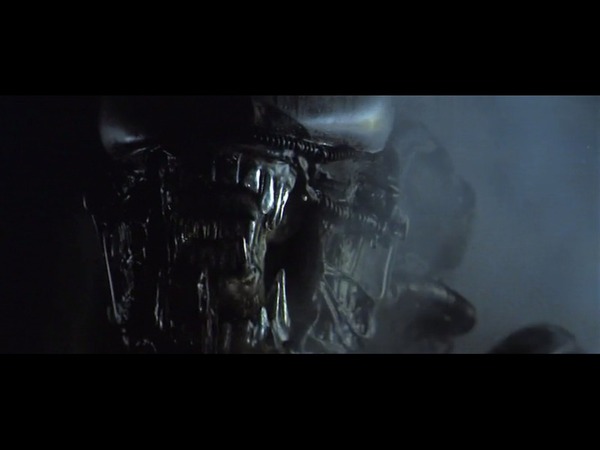
Adult
A hatchling implants a rapidly gestating embryo in its host. The embryo leaves its host in larval form and, as it matures, acquires phenotypical characteristics of the abandoned host organism—bipedal, anthropoidal, possessing a prominent cranium and opposable thumb, etc. It is the alien’s non-human characteristics, however, which reveal the film’s subtext. The ridged tubes which run along the alien’s exterior, its sliding nested mandible, its phallic cranial dome, and its segmented prehensile tail all suggest machinery. The alien resembles a mechanically augmented humanoid, its machinic parts nearly indistinguishble from its organic ones. The alien’s very body is shrouded by morphological ambiguity, a non-distinction between animal and machine.
This theme finds further expression in the literal machines resident on the Nostromo: Ash (Ian Holm) and Mother. After Ripley (Sigourney Weaver) asks Ash how to kill the alien, Ash explains You still don’t know what you’re dealing with: perfect organism. Its structural perfection is matched only by its hostility. Ash, an android, confesses feelings of admiration for the alien’s “purity.” Ash’s last words—you have my sympathies—are a demoralizing taunt one might more expect from a person than a machine.
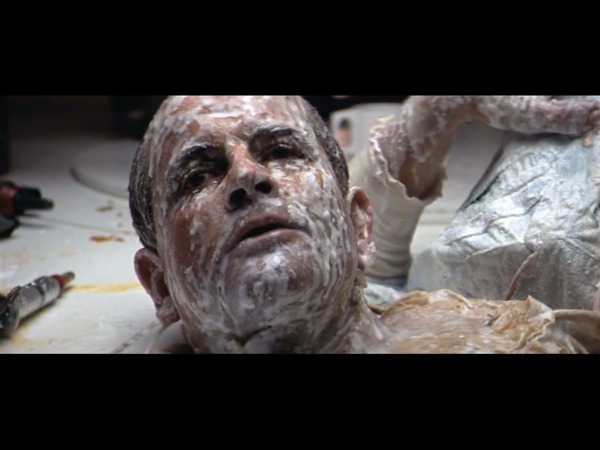
Like the alien, Ash straddles the onotological boundary between organism and machine. Ash is an infiltrator among the Nostromo’s human constituents, and his inclusion places him, figuratively, “on the inside” of the crew’s chain of command and, literally, on the inside of the ship itself. Ultimately, the (thematic) blurring of the boundary between organism and machine is also a matter of containership and interface.
Mother is the other artificial intelligence on the ship and the crew literally sit inside of her in order to communicate with her.
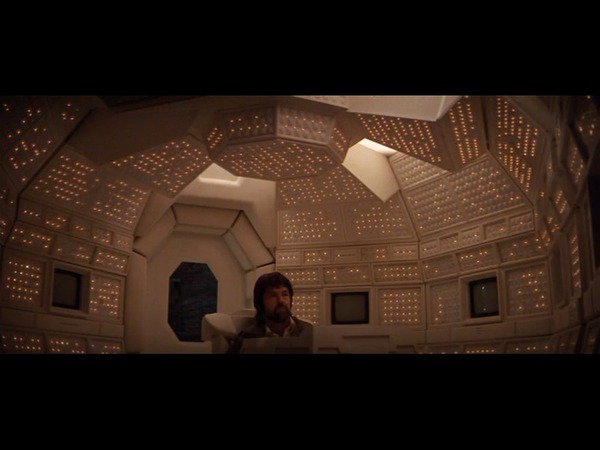
Inside Mother

Sipping

Reaction
Where Dallas (Tom Skerritt) sits passive, occasionally sipping his coffee and absently poking Mother’s keys, Ripley is a hacker possessed. In the scene from whch the above picture of Ripley is taken, Ripley contrives a series of questions and enacts an override to extract from Mother the truth of the Nostromo’s mission. Ripley focuses her awareness, stares in alarm, puts her shoulder into keying, and frowns her displeasure. Ripley is a woman of action, not merely a reversal of stereotypical gender assignment, but an active, passionate/emoting being of her own. She is the Final Girl and a cyborg of formidable proportion.
Speaking of final, the remainder of the film’s key turning points depend on Ripley’s steerage of several cybernetic controls.
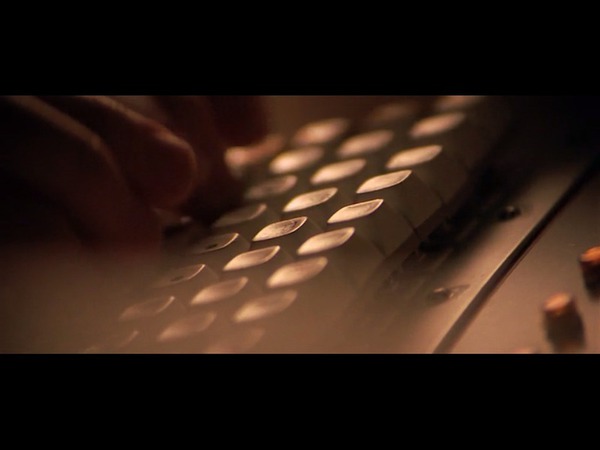
Touching Mother’s keys
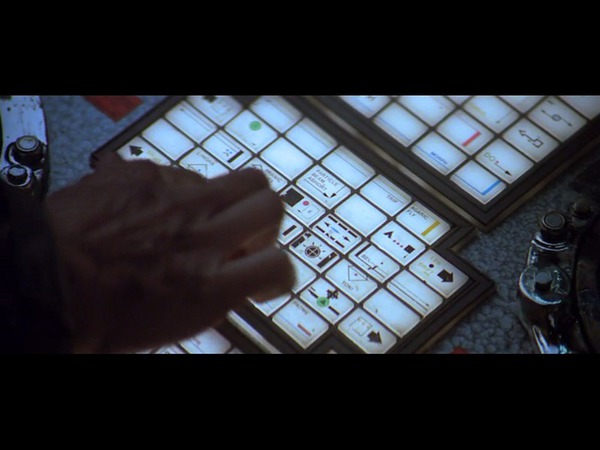
Programming Mother to self-destruct
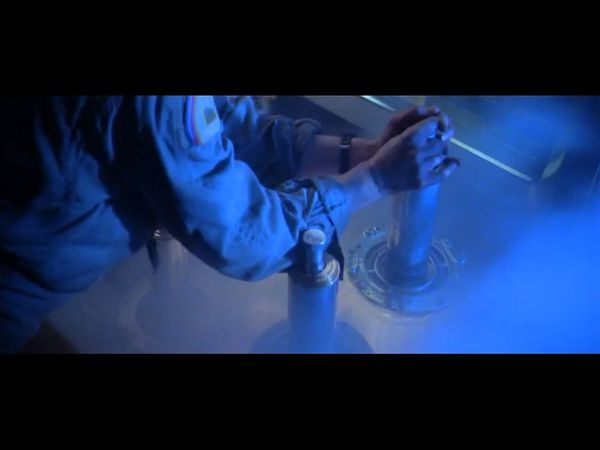
Failure to rescind
Ripley acts at the interfaces governing the ship’s machine logic and homeostatic» controls. She interprets, modifies, and augments the stream of symbols that control the Nostromo’s cybernetic network. Ripley is good with machines, informatic and mechanical. She’s decisive, empathic, and buff. She’s a cyborg, not a goddess.
What is a Network?
One answer to that question is that the cyborg is a network. Cyborgs are assemblages of heterogeneous elements deriving from and/or located in disparate ontological orders.
There still is much to say about the cybernetic aspects of most (all?) networks, but I have not laid the groundwork in these brief» notes which would permit me to do so with a clear conscience. The most I feel comfortable doing is reconsidering what Shelley had to say about the powerful technologies shaping the evolution of humans and non-humans. Today, the generation and maintenance of machine intelligence and the multiplication of systems of extraction and production are leading to what may be irreversible damage to all terrestrial entities, organic and otherwise.
Though dystopias where, say, robots overtake and displace living organisms ring truer to my ears than clean and friendly technotopias wherein machines and animals are harmoniously and symbiotically linked, it is the fear of technology—not technology itself, not the monster—that is Frankenstein’s undoing. Frankenstein destroys his creature’s companion for fear that they would multiply and destroy the human species. The coexistence, let alone symbiosis, of humans and non-humans is not a possibility in Frankenstein’s world.
Is it a possibility in ours?
Comments
#1
Dear Misterquid,
I quite enjoyed your article and since I am writing myself a paper in my MA program about the function of cyborgs in contemporary society, I would like to ask you if it is possible to provide me with your real name, so that when I quote something from your text, it would sound more reliable, rather than stating 'Posted by mistersquid on Wednesday, 29 September 2010'. Please let me know in the provided e-mail here from me. Thanks, R.
PS: Good quote from Zizek on the front page.
Posted by: Rumen | December 8, 2012 12:59 PM
#2
Howdy Rumen,
Thank you for your kind words and good luck on your essay regarding the function of cyborgs in contemporary society.
My full name is Johnnie Wilcox, the same Johnnie Wilcox cited as the last entry in the bibliography to this entry, above. Project Muse provides a direct link to more information for the article I self-cite.
Thanks for visiting and I'd love to hear back if and when you'd like to share some of your ideas.
Johnnie Wilcox
Posted by: mistersquid |
December 8, 2012 6:06 PM
|
December 8, 2012 6:06 PM